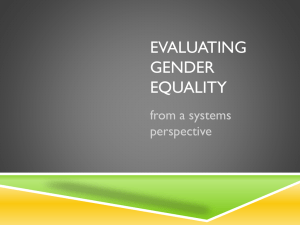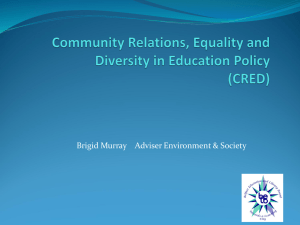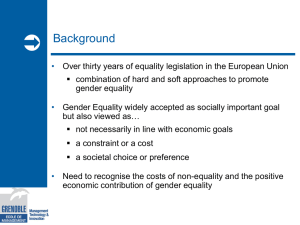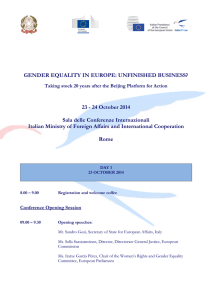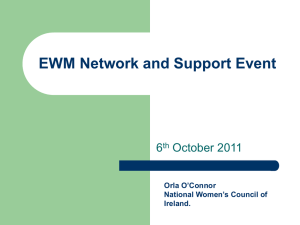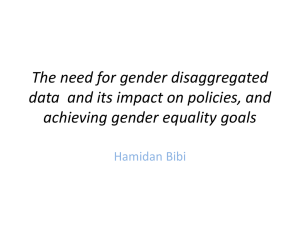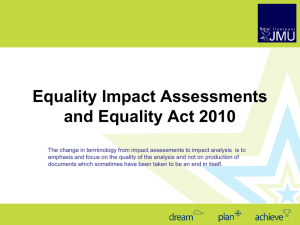community relations, equality & diversity in education policy
advertisement
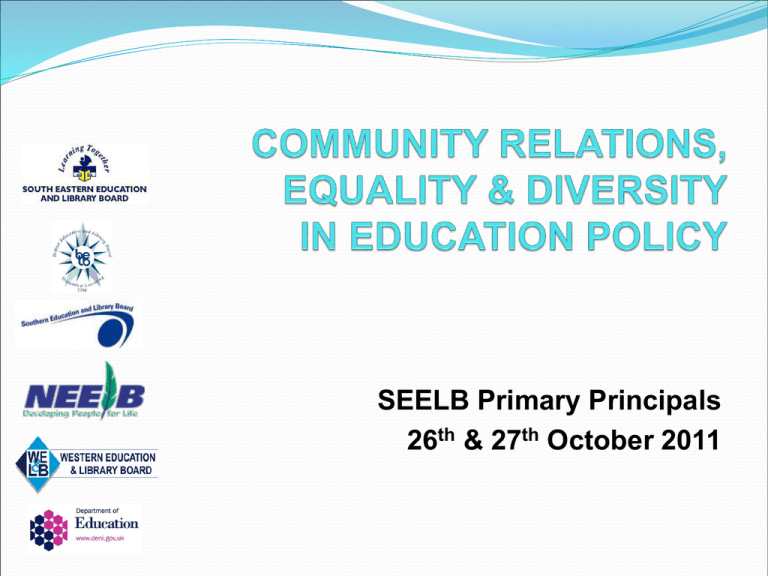
SEELB Primary Principals 26th & 27th October 2011 Community Relations, Equality & Diversity In Education Policy Background Review initiated by Minister June 2008 Working Group Established (17 Reps) Working Group Report June 2009 Education Committee Consulted Jan 2010 Public Consultation commenced 6 September 2010 Community Relations, Equality & Diversity In Education Policy Policy premised on: Equality & human rights UN Convention on the Rights of the Child Commitments in Good Friday, St Andrews & Hillsborough agreements Changes in society & policy context Community Relations, Equality & Diversity In Education Policy Intended Recipients Primary Schools Post-Primary Schools Youth Settings Statutory early years settings Other early years settings – “strongly encouraged” to adopt CRED principles Community Relations, Equality & Diversity In Education Policy Policy Aim Contribute to improving relations between communities by educating children & young people to develop self respect, respect for others, promote equality & work to eliminate discrimination Provide formal & non-formal opportunities to build relationships with those of different backgrounds & traditions within resources available Community Relations, Equality & Diversity In Education Policy Policy Objectives Develop understanding & respect for rights, equality & diversity of all without discrimination Value & respect difference & engage positively with it Equip children/young people with required skills attitudes & behaviors Community Relations, Equality & Diversity In Education Policy Intended Outcomes Understand and respect rights, equality & diversity (incl linguistic diversity) of all Develop skills, attitudes & behaviours to value and respect difference and engage positively with it Based on set of core principles Community Relations, Equality & Diversity In Education Policy Key changes from CR Policy: Wider definition of Community Relations - all section 75 groups (not just two main communities) Reflects changed environment Reflects changes to curriculum Community Relations, Equality & Diversity In Education Policy Key changes from CR Policy: Move away from dependency on external organisations Embed work within schools & youth settings Provide strong skills base for educators Within framework of existing policies Community Relations, Equality & Diversity In Education CRED Website www.credni.org Community Relations, Equality & Diversity In Education CRED Guidelines Community Relations, Equality & Diversity In Education Why a Guidance Document? To line up the CRED policy with the curriculum and related policies To support the change of focus away from ‘old’ concept of Community Relations to include Equality and Diversity To provide support for engagement in unfamiliar and contentious work areas Community Relations, Equality & Diversity In Education Who is it guidance for? Formal and Non Formal Education (Schools & Youth Work settings) Management Committees, Advisory Committees, Boards of Governors Strategic Managers – in Education Authorities Operational Managers – Schools & Youth Delivery staff – teachers and youth workers Community Relations, Equality & Diversity In Education Which specific settings? Early years Schools Primary Post Primary Youth Work Community Relations, Equality & Diversity In Education Schools Can promote CRED through: Child Centred Provision High Quality Learning and Teaching Effective Leadership A School Connected to its Local Community Curriculum: Requires schools to address issues around diversity & inclusion and to consider how people from differing traditions can live together Aims to empower young people to make informed, responsible decisions Community Relations, Equality & Diversity In Education Primary Schools Sits naturally (from Foundation to KS2) in “Personal Development and Mutual Understanding” Strand 1: Personal Development and Health Strand 2: Mutual Understanding in the Local and Global Community Other Curriculum Areas: Language and Literacy The Arts Religious Education Physical Education Community Relations, Equality & Diversity In Education Measuring Success A robust evaluation process is a key aspect of the policy (Self ) Evaluation should assess impact at 4 levels: Reaction of participant Increase of knowledge Behavioural change Results of the learning QA Indicators will be included in Guidance External monitoring of attitudes (e.g. NI Life and Times) Community Relations, Equality & Diversity In Education http://www.deni.gov.uk/cred_policy_doc1.pdf

